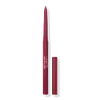What's inside
What's inside
 Key Ingredients
Key Ingredients

 Benefits
Benefits

 Concerns
Concerns

 Ingredients Side-by-side
Ingredients Side-by-side

Cyclopentasiloxane
EmollientDimethicone
EmollientPolyethylene
AbrasiveSynthetic Fluorphlogopite
Sucrose Acetate Isobutyrate
Trimethylsiloxysilicate
EmollientPolypropylsilsesquioxane
C30-50 Alcohols
EmulsifyingPolybutene
Polymethylsilsesquioxane
Triethoxycaprylylsilane
Aloe Barbadensis Leaf Extract
EmollientBis-Hydroxyethoxypropyl Dimethicone
EmollientCetyl PEG/PPG-10/1 Dimethicone
EmulsifyingTocopheryl Acetate
AntioxidantDimethicone Crosspolymer
Emulsion StabilisingDimethicone/Vinyl Dimethicone Crosspolymer
Skin ConditioningPentaerythrityl Tetraethylhexanoate
EmollientBHT
AntioxidantBenzoic Acid
MaskingCI 77891
Cosmetic ColorantCI 45410
Cosmetic ColorantMica
Cosmetic ColorantIron Oxides
CI 15850
Cosmetic ColorantCI 19140
Cosmetic ColorantCI 42090
Cosmetic ColorantCyclopentasiloxane, Dimethicone, Polyethylene, Synthetic Fluorphlogopite, Sucrose Acetate Isobutyrate, Trimethylsiloxysilicate, Polypropylsilsesquioxane, C30-50 Alcohols, Polybutene, Polymethylsilsesquioxane, Triethoxycaprylylsilane, Aloe Barbadensis Leaf Extract, Bis-Hydroxyethoxypropyl Dimethicone, Cetyl PEG/PPG-10/1 Dimethicone, Tocopheryl Acetate, Dimethicone Crosspolymer, Dimethicone/Vinyl Dimethicone Crosspolymer, Pentaerythrityl Tetraethylhexanoate, BHT, Benzoic Acid, CI 77891, CI 45410, Mica, Iron Oxides, CI 15850, CI 19140, CI 42090
 Reviews
Reviews

Ingredients Explained
These ingredients are found in both products.
Ingredients higher up in an ingredient list are typically present in a larger amount.
BHT is a synthetic antioxidant and preservative.
As an antioxidant, it helps your body fight off free-radicals. Free-radicals are molecules that may damage your skin cells.
As a preservative, it is used to stabilize products and prevent them from degrading. Specifically, BHT prevents degradation from oxidation.
The concerns related to BHT come from oral studies; this ingredient is currently allowed for use by both the FDA and EU.
However, it was recently restricted for use in the UK as of April 2024.
Learn more about BHTCi 15850 is the pigment color red. It is an azo dye and created synthetically.
Azo dyes need to be thoroughly purified before use. This allows them to be more stable and longer-lasting.
This ingredient is common in foundations, lipsticks, and blushes. This color is described as brown/orangey red.
It has many secondary names such as Red 6 and Red 7. According to a manufacturer, Red 6 usually contains aluminum.
Learn more about CI 15850CI 19140 is also known as Tartrazine. Tartrazine is a synthetic dye used in cosmetics, foods, and medicine to add a yellow color.
Tartrazine is created from petroleum and is water-soluble.
Some people may experience allergies from this dye, especially asthmatics and those with an aspirin intolerance.
Learn more about CI 19140Ci 77891 is a white pigment from Titanium dioxide. It is naturally found in minerals such as rutile and ilmenite.
It's main function is to add a white color to cosmetics. It can also be mixed with other colors to create different shades.
Ci 77891 is commonly found in sunscreens due to its ability to block UV rays.
Learn more about CI 77891This ingredient is a combination of red, black, and yellow iron oxide pigments. This combination of colors is usually found in foundation, because it results in a "skin" color.